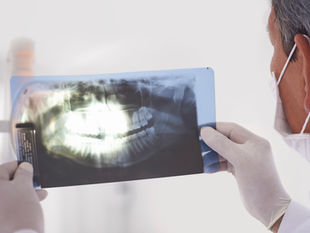
Mandibular Advancement Devices: A Comfortable, Effective Alternative to CPAP
Aug 22
4 min read
0
9
0
For many adults diagnosed with obstructive sleep apnea (OSA), continuous positive airway pressure (CPAP) is prescribed first. But if the mask, hoses, or pressure make CPAP hard to live with, a custom mandibular advancement device (MAD)—a dentist-fitted oral appliance—can be a proven alternative to CPAP and a highly effective sleep apnea treatment.
Below, we explain how MADs work, who they help, and what the science says about comfort, adherence, and health outcomes.

What is a mandibular advancement device?
A MAD is a small, custom oral appliance that gently positions the lower jaw forward during sleep. This helps open and stabilize the upper airway, reducing snoring and apneas. The device is adjustable (“titrated”) over several visits to balance effectiveness with comfort. Clinical guidelines from the American Academy of Sleep Medicine (AASM) recommend oral appliance therapy for adults with OSA who are intolerant of CPAP or prefer an alternative, and for primary snoring after proper evaluation. (PMC, JCSM, AASM)
Comfort drives higher night-to-night use
Comfort matters—because a therapy only works when you actually use it. Multiple studies show patients tend to wear MADs longer per night and more nights per week than CPAP, even though CPAP typically reduces the apnea–hypopnea index (AHI) more on a per-night basis. Objective and self-reported data show comparable objective adherence and higher self-reported adherence with oral appliances over time. (JCSM)
In real life, that comfort-driven adherence can level the playing field for important outcomes. In a randomized crossover trial, 1 month each on CPAP and on a MAD improved sleepiness and health markers similarly—suggesting the effectiveness of MADs can rival CPAP when people actually use them. (PubMed)
Health outcomes: effectiveness that translates beyond the AHI
While CPAP remains the most potent at lowering AHI in a lab setting, several trials and meta-analyses show that clinical outcomes—like daytime symptoms and blood pressure—can be similar with MADs because patients often wear them more consistently:
Blood pressure & cardiovascular risk: A large randomized non-inferiority trial in patients with hypertension and OSA found a MAD was noninferior to CPAP in reducing 24-hour mean arterial blood pressure, a key cardiovascular risk marker. (PubMed, JACC)
Symptoms & quality of life: Randomized comparisons report comparable improvements in daytime sleepiness and function between therapies, despite CPAP’s greater AHI reduction. (PubMed)
Long-term outcomes: Two-year and longer follow-ups show stable benefits with either therapy; CPAP lowers AHI more, but oral appliances deliver durable improvements with better tolerance for many patients. (Oxford Academic, JCSM)
The guideline perspective
The joint AASM/AADSM clinical practice guideline is clear: CPAP is generally first-line for OSA because it most effectively reduces AHI and oxygen desaturations. However, for adults who can’t tolerate CPAP or who prefer an oral appliance, a custom, titratable MAD prescribed by a sleep physician and provided by a qualified dentist is recommended—with ongoing dental follow-up to monitor bite or tooth changes. (PMC)
Who is a good candidate?
Mild to moderate OSA: Many patients achieve strong results and high satisfaction with a MAD.
Severe OSA but CPAP-intolerant: A MAD is an evidence-based alternative to CPAP that can meaningfully reduce events and improve symptoms when CPAP isn’t workable.
Frequent travelers & light sleepers: No mask, no hose, no power outlet—quiet, portable, and convenient often means better consistency.(Your sleep physician’s prescription and a dental sleep specialist’s evaluation determine fit and expected benefit.) (PMC)
What to expect from treatment
Prescription & referral: After diagnosis by a sleep physician, you’re referred for oral appliance therapy.
Custom fitting: A dental sleep specialist takes digital scans/impressions to fabricate a custom, titratable device.
Titration & follow-up: The device is adjusted over weeks to improve symptoms and minimize side effects (jaw or tooth soreness, bite changes).
Verification sleep study: A repeat sleep test confirms your new baseline. Ongoing dental and sleep follow-up keep results on track. (PMC)
Why choose an orofacial pain specialist for your MAD?
Because a mandibular advancement device repositions the jaw every night, it directly affects the temporomandibular joint (TMJ) and surrounding muscles. An orofacial pain specialist has advanced training in TMJ disorders and jaw biomechanics, making them uniquely qualified to design, fit, and adjust these devices safely. This expertise not only improves comfort and effectiveness but also reduces the risk of jaw pain, bite changes, or other complications over time.
Key takeaways
Comfort → adherence → real-world results. MADs are smaller, quieter, and easier to travel with—which often leads to better nightly use and comparable improvements in symptoms and blood pressure versus CPAP. (JCSM, PubMed)
Evidence-based option. Major guidelines endorse oral appliances for adults who can’t tolerate CPAP or prefer an alternative to CPAP. (PMC)
Team-based care works best. The most effective sleep apnea treatment pairs a sleep physician’s diagnosis and oversight with a dentist trained in dental sleep medicine for fitting and long-term monitoring. (AASM)
Selected scientific references
AASM/AADSM Clinical Practice Guideline for Oral Appliance Therapy in OSA (2015; reaffirmed/updated communications). (PMC, JCSM)
CRESCENT Trial (2024): MAD noninferior to CPAP for 24-hr mean arterial BP in OSA with hypertension. (PubMed)
Phillips et al. Randomized crossover trial: similar improvements in health outcomes with CPAP and MAD despite CPAP’s greater AHI reduction. (PubMed)
Doff et al., SLEEP (2013): Two-year outcomes: durable benefits with both therapies; CPAP lowers AHI more, MAD better tolerated by many. (Oxford Academic)
JCSM (2019): Objective adherence comparable; self-reported adherence higher with MAD over time. (JCSM)
If you’re exploring an alternative to CPAP, a custom mandibular advancement device—guided by your sleep physician and fabricated by a dental sleep specialist—may offer the right balance of comfort, adherence, and real-world effectiveness. Ready to see if you’re a candidate? Schedule a consultation and we’ll walk you through your options.






